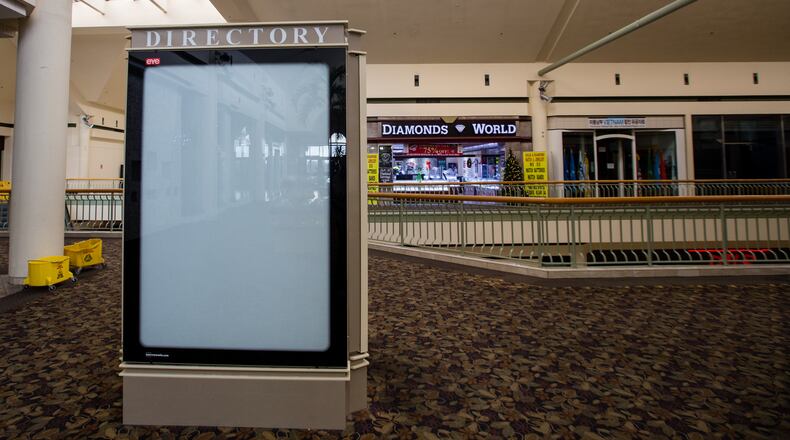Mike Lowrey stood in a Costco Friday afternoon, getting choked up as he thought about The Wiggles.
It was 2001, and as Lowrey remembers it, the musical group — a one-time behemoth with the pre-school set — brought 10,000 visitors to Gwinnett Place Mall.
The concerts, the promotions, the Santa Claus with a sled pulled by two real reindeer: “It was a lot of fun back in those days,” said Lowrey, a former Gwinnett Place general manager. “I look back on it now, it was an age of innocence.”
Since then, of course, people’s shopping habits have changed. The mall has fallen out of favor. And Gwinnett Place, in particular, has suffered.
After years of prodding, Gwinnett County commissioners this month announced they had bought much of the 1.278-million-square-foot mall and its parking lot — a total of 39 acres — for $23 million.
» MORE: What has been proposed at Gwinnett Place Mall?
What will happen to the property is yet unknown. The remaining three anchor stores own their land, a fourth was purchased previously by a developer and there are still a handful of stores open in the mall’s interior. Three new county commissioners, who will take office next month, will help set the tone for the site’s future.
But chances are high that its days as a mall are numbered. And so for Lowrey and others, even as they lauded the opportunity to remake the area into something better, the tears were not far from the surface.
“It’s pretty sad even talking about it,” Lowrey said of Gwinnett Place’s demise. “It was like a slow-moving train wreck.”
‘Flying high’
Gwinnett Place was the brainchild of Scott Hudgens, a real estate developer who put the shopping palace at the site of a former trailer park, near a 24-hour truck stop. When it was built off I-85 and Pleasant Hill Road in Duluth, Tom Wheeler remembered, “There weren’t that many roads out there.”
The 1984 opening drew then-Gov. Joe Frank Harris, wielding a $30,000 pair of diamond-studded scissors and declaring Gwinnett Place a “monument to the free-enterprise system,” The Atlanta Journal-Constitution reported. Two years later, Wayne Shackelford, a developer who went on to lead the state Department of Transportation, called the mall “the nerve center of Gwinnett County.”
“Regional malls have replaced city halls as the centers of activity,” Shackelford said in 1986. “Development radiates from them now, just like our nation grew up around city halls.”
Hudgens “was a visionary for his time,” said Wheeler, who was president of Hudgens Cos. when Gwinnett Place was built. “This was a coming of age for Gwinnett.”
Bill Gullion, the general manager when Gwinnett Place opened, remembers it as a no man’s land when the mall was being built. He said in the early days, he had to run off prostitutes who came from the nearby truck stop. At the same time, the “tremendous crowds” caused backups on Pleasant Hill. An opening night party featured a string orchestra and more than $5,000 worth of liquor for 3,000 invited guests.
“There was so much hope, so much enthusiasm and optimism,” Gullion said. “Success came a lot faster than we anticipated.”
People drove from as far as South Carolina to shop, and the mall was fourth in sales per square feet in metro Atlanta, Gullion recalled. Glenn Wisdom, the former general manager of the Gwinnett Place J. C. Penney, said it had been the highest-grossing Penney store in the state.
“It was flying high, it was the place to be,” said Wisdom, now the director of operations for the Gwinnett Place Community Improvement District. “We were dying to get into the market.”
But the heyday ended when the Mall of Georgia opened in Buford in 1999, followed by Discover Mills — now Sugarloaf Mills — in Lawrenceville in 2001.
The new shopping destinations cut sales in half, said Lowrey, who left Gwinnett Place to become the Mall of Georgia’s general manager in the early 2000s. Tenants left for the new malls, leaving empty holes.
The mall sputtered. In 2013, it was purchased by Moonbeam Capital Investments, a group that promised revitalization. But it never came.
‘In our DNA’
For nearly 20 years, Joe Allen has been working to improve the area around the mall. As executive director of the Gwinnett Place Community Improvement District, Allen said it pains him to see “the ghost town it has become.” He remembers when the mall “was the center of the universe;” thinking of taking his son to meet Santa there still gives Allen chills when he thinks of how his face lit up.
“It really put Gwinnett on the map,” Allen said. “Everyone knows where Gwinnett Place is. It’s in our DNA; we can probably find it blindfolded.”
Eric Teusink, who grew up in Gwinnett, recalls running around the mall in a pack of 13-year-old boys, hoping to find a pack of 13-year-old girls near the mall’s fountain to make awkward conversation. He has fond memories of skateboarding “briefly and poorly” in the parking lot and of an easily accessible cigarette machine near a Ruby Tuesday on the mall’s upper level.
“It was a somewhat unregulated playground for young teens and preteens,” said Teusink, 39. “It was a brief and beautiful period in a young boy’s life.”
Joshua Garcia, 19, is also mourning Gwinnett Place. The Lawrenceville resident remembers shopping at J. C. Penney with his family before the store closed, and eating lunch at a Chinese restaurant in the food court. He went to the mall at least once a month.
“If you were just bored in the house, you would go to the mall and see what was there,” he said. “Nobody goes to the mall like they used to before.”
Ellen Dunham-Jones, a professor of architecture and urban design at Georgia Tech, said men tend to be more nostalgic about malls — which were often anchors for their social lives. Women, she said, tend to comparison shop and are quicker to move on to the next set of stores.
Gwinnett Place had long been a default downtown for Gwinnett County, and became a symbol of the suburban lifestyle the county could provide, Dunham-Jones said.
“I think it definitely ends a significant establishment or moment in Gwinnett history,” said Kirkland Carden, the newly elected county commissioner representing the area whose first job was at the Gwinnett Place Abercrombie & Fitch.
Carden and his friends saw celebrities at the mall — Bow Wow, Bonecrusher, Lil Jon — and MTV scouting people for reality shows. At the time, he said, it was “full of young people with time to kill.” Now, Carden describes Gwinnett Place as “hollow and empty and cold.”
He doesn’t see much purpose for the mall anymore. As a member of the board that will make the decision about Gwinnett Place’s future, Carden will have a say in what happens to the “obsolete” Gwinnett Place.
“Nothing lasts forever,” he said. “We have a chance to make something modern. ... Gwinnett is not the Gwinnett of the 1980s. It’s different. We’re going to see more iconic figures in Gwinnett morph and change.”
About the Author
Keep Reading
The Latest
Featured



